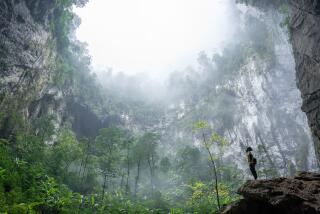Spectacular View
- Share via
Viewers of public television have been treated in recent years to a large number of outstanding series on science, from “Cosmos” to “Nova” to “The Brain.” Science on television has learned to use the full range of production techniques and special effects that the medium offers, and many of the resulting programs have been exciting to watch as well as informative.
Even against this high standard, a new series on geoscience that gets under way tonight deserves special note. The seven-part series, called “Planet Earth,” tells the riveting story of the dynamic forces that affect and shape the Earth, stars and planets. “Mountains, oceans and continents are but the ephemeral manifestations of a continual cycle of creation and destruction,” says Richard Kiley, the narrator, in the clear and well-wrought style that marks the series.
But most impressive are the pictures. Viewers get to see thrilling things that they probably haven’t seen before: scientists collecting molten rock from the Kilauea volcano in Hawaii, an earthquake in progress, flaming boulders spewing from inside the Earth on the ocean floor.
Most important, “Planet Earth” presents science as a method for understanding the world, and shows how hypotheses are developed, tested and confirmed (or discarded). It shows how scientists build on the work of their colleagues, and how experimental results beget new experiments. It shows that science is in constant change, just as the Earth is.
The programs were produced by WQED in Pittsburgh in association with the National Academy of Sciences under grants of $3 million from the Annenberg/CPB Project and $1 million from IBM. A college-level course keyed to the programs has been prepared, and educational materials are also available to junior and senior high school students.
This is one of those happy projects in which everybody gains. Those who tune in to Channel 28 tonight at 8 will consider their time well rewarded.
More to Read
The complete guide to home viewing
Get Screen Gab for everything about the TV shows and streaming movies everyone’s talking about.
You may occasionally receive promotional content from the Los Angeles Times.






